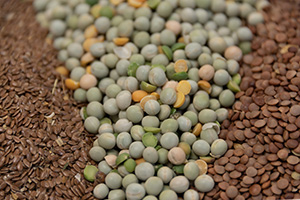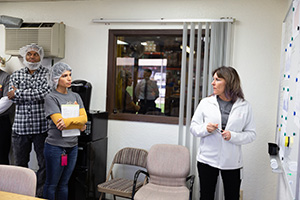Pet food manufacturers are facing supply chain disruptions caused by both the pandemic and increased demand, according to Peg Ray, senior manager, product development and innovation, AIB International, Manhattan, Kan.
To help mitigate this strain, industry experts said long-term planning and a shift away from “just-in-time” operations could be key to business operations in the future.
Becoming more flexible
Dana Brooks, president and chief executive officer of Washington, DC-based Pet Food Institute, said the pandemic disrupted human food production which impacted the availability of ingredients used in pet foods.
Additionally, Brooks said federal and state mandates along with incentives for promoting renewable fuel production have resulted in increased and unfair competition for oils and fats, which is stressing the ingredient supply chain even further. She said this has created an advantage to the energy sector and a disadvantage for companies purchasing ingredients for pet food.
Brooks also noted bottlenecks at ports have added to the challenges in securing ingredients, and domestic transportation issues continue to make it difficult for companies to ensure vehicles, drivers and pallets.
Rick Ruffolo, president and chief executive officer, Phelps Pet Products, Rockford, Ill., said all aspects of the supply chain for pet foods and treats were impacted by the pandemic during the last two years. The primary concerns from his perspective were product availability, increased lead times and higher costs, but he said the most critical issue was the overall unpredictability of the supply chain.
“This unpredictability has forced us to develop a greater degree of flexibility in our production planning process and expand our base of vendor partners to increase our sources of supply of specific ingredients and materials,” Ruffolo said.
He said many planning meetings that previously occurred once a month are now happening on a weekly or even daily basis as they evaluate contingency scenarios based on the latest supply chain information. The company also purchased additional ovens and added more packaging lines at the beginning of 2021 to increase production capacity and flexibility.
Jorge Martinez Carrillo, president of pet solutions, ADM Animal Nutrition, Decatur, Ill., said flexibility can be achieved by designing buffers in end-to-end processes and focusing on environmental sustainability.
 Establishing longer-term supply commitments for key commodities has helped Canidae close potential gaps in production. (Source: Sosland Publishing Co.)
Establishing longer-term supply commitments for key commodities has helped Canidae close potential gaps in production. (Source: Sosland Publishing Co.)
“We believe that a just-in-time supply chain with high levels of carbon emissions, high dependence on natural resources and a limited number of suppliers will not have a future in pet food,” Carrillo said. “On the contrary, practices that will become a must — not an option — for the industry include integrating local raw material suppliers, having multiple manufacturing options, cultivating large and energy efficient distribution networks, integrating sales and operations planning, sharing data in real time, and vendor-managed inventory.”
Ruffolo said it only takes one missing ingredient to shut down production of a product, so ensuring the team is working through all the potential alternatives in advance can help speed up response time to issues that arise. He added it’s important to constantly communicate and keep all stakeholders updated about the latest developments. The more communications happen in real-time, the better everyone can become in solving problems.
Empathy and patience are also important as everyone is experiencing similar issues, Ruffolo said.
“Every ingredient vendor, packaging supplier, contract manufacturer and retail buyer are doing their best to make things happen,” Ruffolo said. “We all want to meet and exceed expectations, but sometimes things are simply outside of your control. You only can do what you can do.”
Brian Moynihan, vice president of supply chain, Alphia, Bern, Kan., said the company has made some product reformulations due to ingredient shortages. Still, it has made its biggest change to long-term planning by placing more emphasis on such planning to better align supply strategies and meet demand. He also noted the company has moved some of its support roles in scheduling and purchasing to remote positions, and this has given rise to opportunities for new talent as it is no longer restricted to recruiting for roles in specific geographic areas.
Moynihan said items from overseas are requiring longer lead times, and domestic droughts in the Midwest and grain supply issues in Canada are creating some scarcity as well. Ingredients that are purchased in bulk and just-in-time are especially challenging, he added, and to help mitigate this Alphia has been changing its plans based on a dynamic ingredient supply constraint to maximize output.
Alphia has made many scheduling changes due to supply chain issues, and by putting standardized practices in place the company can have better control and greater visibility to mitigate risk for customers, he noted.
 Domestic transportation has been impacted by widespread labor shortages causing irregularity in available vehicles and drivers. (Source: ©dell - stock.adobe.com)
Domestic transportation has been impacted by widespread labor shortages causing irregularity in available vehicles and drivers. (Source: ©dell - stock.adobe.com)
Wally Shaw, chief operating officer, Canidae, Stamford, Conn., said exotic proteins like goat and lamb frequently come from overseas and have been difficult to source. He said more planning needs to go into purchasing more common ingredients such as chicken fat to ensure there is enough time to receive a supply.
Shaw said the company is cognizant of its yield and scrap rates, and it schedules its plants as efficiently as possible. Longer runs are more favorable for better output, and the company is stocking more raw material inventory than usual to mitigate delivery disruptions and avoid down time in extrusion. The company has also looked to longer-term volume agreements, which was helpful in protecting the company in the face of material shortages.
Preventing fraud and promoting safety
As ingredients are stretched thin and sometimes become scarce, opportunities and motivation for adulteration of products becomes possible.
“Procurement should know that economically motivated adulteration is possible during supply shortages, making food fraud an issue,” Ray said. “Adhering to your company’s approved supplier protocols for inspections, third-party audits, food safety plan reviews, sampling and testing of ingredients are necessary with all suppliers to ensure that food safety is not compromised.”
While she is not aware of any recent instances of pet food products being adulterated, Ray advised processors should only purchase from suppliers that are known to be reputable, test their products and provide accurate information. If an ingredient that was once short on supply suddenly becomes available, it could be an instance of food fraud, Ray noted. If a company understands what products are most likely to be adulterated and what adulterants might be used, they can specifically test those products before use.
Ray said staffing shortages can cause companies to bring in new workers that are not familiar with roles in the processing plant and are not trained in food safety. This also highlights the need to make sure all staff are trained in food safety despite the supply chain disruptions and staffing shortages.
Ray also recommended companies stock up on a six-month supply of personal protective equipment and sanitation materials in case there are any supply chain disruptions for those materials.
Finding success through the stress
Despite the challenges, companies have experienced success. Shaw said Canidae chose to enter longer-term volume agreements to secure commodity volume commitments in 2021, and this helped protect the company when there were material shortages. While there were challenges in supplying some ingredients in time, Canidae did not have significant gaps last year, according to Shaw.
 Being able to adapt procurement and production planning quickly and efficiently is key to maintaining smooth production through supply chain volatility. (Source: Sosland Publishing Co.)
Being able to adapt procurement and production planning quickly and efficiently is key to maintaining smooth production through supply chain volatility. (Source: Sosland Publishing Co.)
Because ADM Animal Nutrition has experience with various disruptions to the supply chain, Carrillo said the company has learned to better manage the logistical problems and was able to help brands adapt their pet food formulations with ingredients more readily available in their region.
Still, the challenges remain. Moynihan said the industry will likely see many of the same challenges throughout 2022.
“Building supply chain resilience, notably through design, has gained a lot of traction with all stakeholders,” Carrillo said. “No longer a theoretical focus, the need to consider significant strategy changes throughout the supply chain has become a big rock for policymakers, suppliers, distributors and customers.”
Read more about supply chain topics affecting the industry on our Operations page.




